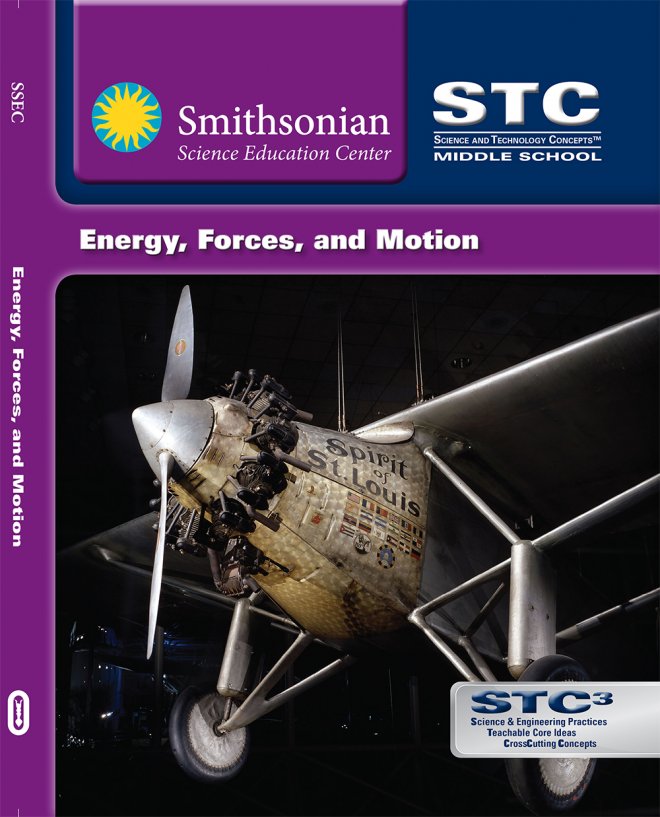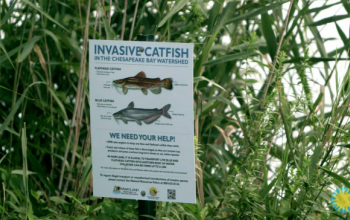STCMS™: Energy, Forces, and Motion
It's time to get a move on! Motion is part of our daily lives-riding in a car, playing a sport, even dropping a coin. The Smithsonian Science Education Center presents Energy, Forces, and Motion, an STCMS™ curriculum unit designed from the ground up to align to the Next Generation Science Standards. Science and engineering practices, teachable core ideas, and crosscutting concepts are integrated into every lesson. The unit relates Newtonian physics to objects that roll, fall, and collide. Join us as we plan investigations and design solutions to explore energy, forces, and motion!
You can find all Blackline Masters here. For teacher Lesson Masters and unit Written Assessments, go to Carolina Science Online.
Lesson 1- Pre- Assessment: Let's Get Moving!
Teacher's will find this to be a useful resources on common misconceptions from the American Association for the Advancement of Science.
Lesson 2- Force, Velocity, and Acceleration
Social Studies/Art
Have students research the history of the development of American cars and discuss which features have changed over time and which ones have remained consistent. Students can start their research at The American Museum of Natural History.
NGSS: (Supports MS-ETS1-2)
Common Core: ( RST.6-8.7, RST6-8.10)
Social Studies/Art
Ask students to synthesize the multimedia in this exhibition into a succinct timeline that represents major advances in transportation routes in the United States. Ask students to identify which of these events is most influential in their daily lives and why.
NGSS: (Supports MS-ETS1-2)
Common Core: ( RST.6-8.7, RST6-8.10)
Lesson 3- Magnetic Forces
Lesson Link
Ask students to read the following article: Outfitting Football Helmets with Magnets Could Reduce Concussions. Have students provide a few sentences in response to the following questions: What are some other areas where we could apply the technology featured in this article to also help minimize injuries due to collisions? Propose 2-4 other areas and why you think this technology could be useful for increasing health and safety.
NGSS: (Supports ETS1.B)
Common Core: (W.6-8.2 )
Language Arts
Ask students to read the blog post: Mounting Photographs with Earth Magnets from an intern at Smithsonian Archives and answer the following question: What was the author's purpose in writing this post? Use this as an opportunity to discuss with students the roles internships can play in college and career readiness.
NGSS: (Supports ETS1-3)
Common Core: (RST.6-8.6)
Lesson 4-Newton's First and Second Law
Lesson Link
Ask student to review the National Air and Space Museum's web page on the four forces of flight. Have students draw a diagram of a plane mid-flight and briefly describe each of the four forces using their own words.
Science
Ask students to watch the following video: Falling 101 . Have students prepare a brief statement to answer the following question: Why do our everyday experiences lead us to misunderstand how gravity works?
NGSS: (Supports MS-PS2-4)
Common Core: (RST.6-8.9)
Lesson 5- Kinetic and Gravitational Potential Energy
Lesson Link
(This requires YouTube to be enabled)
Ask students to view the following video about animation from Pixar and ask them to describe the following: How do animators and artists use a viewer's frame of reference to give the appearance of motion?
NGSS: (Supports MS-ETS1-4)
Common Core: ( RST.6-8.9)
Science
Ask students to review the content on space exploration provided by the National Air and Space Museum here and develop a table illustrating the different methods we have for exploring space, examples of areas these methods have explored, and a sketch representing how these methods work.
NGSS: (Supports ETS1-3)
Common Core: (W.6-8.2.A)
Lesson 6- Newton's Third Law
Lesson Link
Ask students to review misconceptions about gravity in this episode of Good Thinking. Following their viewing, ask students to ask 2-3 people who are not in their science class "What falls faster, 1 ton of bricks or 1 ton of feathers?" and record the responses. In class, discuss the responses and ask the class to determine whether they uncovered any misconceptions. Prompt students to reflect upon why these misconceptions might be so prevalent. This activity will review and strengthen concepts from students who may have watched this video as part of an earlier extension. This is by design.
NGSS: (Supports MS-PS2-4)
Common Core: (RST.6-8.9)
Science
Challenge students to read the description of the Foucault Pendulum and, based on the text, draw a diagram of how they could set up their own pendulum. Description of Foucault Pendulum
NGSS: (Supports MS-PS3-2)
Common Core: (RST.6-8.7)
Lesson 7- Collisions
Science
Ask students to use the game Bumper Ducks to examine a model of Newton's third law in action. Tell students this is one model for understanding Newton's third law and ask them where the model is effective and where it can be improved.
NGSS: (Supports MS-PS2-1)
CCSS: (RST.6-8.9)
Technological Design
Ask students to draw an annotated diagram demonstrating how Newton's 3 laws can be used to explain flight and space travel using Smithsonian's Air and Space website as support: Smithsonian National Air and Space Museum
NGSS: (Supports MS-PS2-1, MS-PS2-2)
Common Core: (RST.6-8.7, RST6-8.10)
Lesson 8- Transforming Energy
Lesson Link
Ask students to read all the way through the online exhibit on auto safety found here: Auto Safety History - National Museum of American History. Ask students to convert the information found here into a timeline highlighting which 5 innovations they think were most important to car safety.
NGSS: (supports MS-ETS1-3)
CCSS: (RST.6-8.9)
Engineering and Design
Ask students to locate the resources about driverless cars. Do you believe that driverless cars have the potential to reduce or eliminate car collisions? Why or why not? Use evidence found from your readings and read Will Driverless Cars Mean Less Roadkill?
NGSS: (supports MS-ETS1-1)
CCSS: (RST.6-8.1)
Lesson 9- Assessment
Science
Ask students to watch the following video: Falling 101 . Have students prepare a brief statement to answer the following question: Why do our everyday experiences lead misunderstandings around energy?
NGSS: (Supports MS-PS3-1)
Common Core: (RST.6-8.9)
Science
Create several simple devices that you can use to demonstrate what you discovered about forces in this lesson. For example, you might investigate what a Rube Goldberg device is, and create and test one. You might produce a device using snap-together toys you have at your home. After you have tested and are satisfied with your designs, demonstrate your models to your family and friends and explain the concepts. Be ready to answer questions about what you did and the results you observed.
NGSS: (Supports MS-PS2-2, MS-PS3-5)
CCSS: NA
Pre-Assessment: Let's Get Moving
Huddlestone Arch
The Huddlestone Arch in Central Park was constructed without the use of mortor to keep it together.
Lesson 2- Force, Velocity, and Acceleration
The Four Forces
Lesson 3- Magnetic Forces
Learning about Magnets, Electricity, and Acceleration at the Amusement Park
Learn about the physics of rollercoasters
Lesson 4- Newton's First and Second Law
Frames of Reference
Lesson 5- Kinetic and Gravitational Potential Energy
What Is a Calorie?
Lesson 6- Newton's Third Law
Newton's Laws of Motion
Learn about Newton's third law of motion
Lesson 7- Collisions
When Galaxies Collide: The Fate of the Milky Way
We only have 4 billion years until we crash into the the Andromeda Galaxy.
All the Gold in the Universe Could Come from Collisions of Neutron Stars
Learn about a new theory on where gold and other heavy elements came from
Lesson 8- Tranforming Energy
Exploring Solar Energy: The Science Behind Design
A lesson on Exploring Solar Energy from Cooper Hewitt
Powering a Generation of Change
The story of electrical power restructuring in North America
The Process of Invention
Learn about the process of invention
Lesson 9- Assessment
Science: A Work in Progress
Take a tour through the Wright brothers' workshop





Kit Tips & Tricks